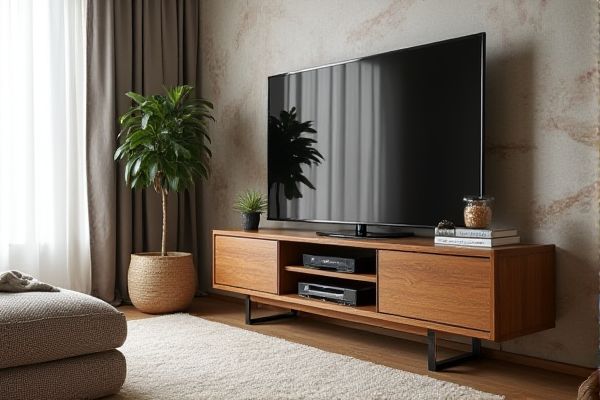
A media console offers a compact, versatile solution for organizing your electronic devices with a modern aesthetic, while an entertainment center provides a larger, more comprehensive unit that often includes additional storage and display options for your entire multimedia setup. Explore the full article to discover which choice best suits Your space and entertainment needs.
Table of Comparison
| Feature | Media Console | Entertainment Center |
|---|---|---|
| Primary Function | Stores and organizes media devices like TVs, soundbars, and gaming consoles | Houses TV, media devices, and additional storage for decor, books, and accessories |
| Size | Compact and minimalist | Larger, bulkier with more storage space |
| Storage | Limited shelves and cabinets for electronics | Multiple shelves, cabinets, and sections for varied items |
| Design Style | Modern and sleek | Traditional to contemporary, often ornate |
| Placement | Versatile, fits smaller rooms | Best in larger living rooms or dedicated media rooms |
| Functionality | Focus on media device organization and cable management | Combined entertainment storage and display unit |
| Price Range | Usually affordable and budget-friendly | Can be more expensive due to size and material |
Understanding Media Consoles and Entertainment Centers
Media consoles are compact, versatile furniture pieces designed to support and organize audiovisual equipment such as TVs, gaming consoles, and streaming devices. Entertainment centers offer a larger, integrated storage solution with multiple shelves and compartments for media players, speakers, and decorative items, often serving as a focal point in a living room. Your choice depends on available space and the need for storage versus a streamlined, minimalist setup.
Key Differences Between Media Consoles and Entertainment Centers
Media consoles are typically low-profile furniture designed specifically to hold electronic devices such as TVs, gaming consoles, and audio equipment, offering sleek storage with minimal bulk. Entertainment centers, however, provide a larger, more comprehensive unit often including shelves, cabinets, and space for decorative items, combining media storage with room organization. The key difference lies in size and function: media consoles prioritize compact, accessible storage for media devices, while entertainment centers focus on multifunctional, spacious solutions for entire living room setups.
Space Requirements and Room Compatibility
Media consoles typically require less space than traditional entertainment centers, making them ideal for smaller rooms or apartments. Their compact design allows for versatility in room compatibility, easily fitting under TVs or against walls without overwhelming the space. Choosing the right piece ensures Your room maintains a balanced layout while providing necessary storage and media organization.
Storage Capacity and Organization Options
A media console typically offers limited storage capacity with open shelves and a few compartments designed for media players and small accessories, making organization straightforward but minimal. An entertainment center provides extensive storage options, including cabinets, drawers, and adjustable shelving, allowing for better organization of various electronic devices, media collections, and decorative items. Choosing between the two depends on the need for space efficiency versus comprehensive storage and display capabilities.
Style and Design Variations
Media consoles feature sleek, minimalist designs ideal for modern or contemporary interiors, often incorporating open shelving and cable management for a clean look. Entertainment centers offer versatile style options, including traditional wood finishes and built-in cabinets, providing ample storage for various media components and decor. Your choice depends on whether you prefer a compact, streamlined unit or a larger, statement piece that complements existing room aesthetics.
Installation and Assembly Considerations
Media consoles typically offer straightforward installation with lightweight materials and simple assembly instructions, making them ideal for quick setup in small spaces. Entertainment centers often require more complex assembly due to their larger size, heavier components, and integrated features like shelving, cable management, and hidden compartments. Careful measurement and secure anchoring are essential during installation to ensure stability and safety, especially for bulky entertainment centers.
Media Console vs Entertainment Center: Cost Comparison
Media consoles typically offer a more budget-friendly option, with prices ranging from $100 to $500 depending on size and materials, making them ideal for small to mid-sized living spaces. Entertainment centers often come with higher costs, usually between $400 and $1,500, due to their larger size, additional storage compartments, and built-in features like shelves for speakers and media devices. Cost varies widely based on brand, design complexity, and included functionality, with media consoles focusing on simplicity and entertainment centers catering to comprehensive home theater setups.
Functionality and Versatility
Media consoles prioritize functionality with compact designs tailored to house media devices like gaming consoles, streaming players, and sound systems, often featuring cable management and ventilation. Entertainment centers offer greater versatility by combining storage for media equipment with additional compartments for decor, books, and other household items, making them a multifunctional furniture solution. Both furniture types enhance living spaces, but media consoles excel in equipment organization, while entertainment centers provide broader storage options.
Best Uses for Media Consoles
Media consoles are ideal for compact living spaces where efficient storage and easy access to media devices are essential. Their streamlined design accommodates TVs, gaming consoles, and sound systems while offering cable management to keep your setup organized. Choosing a media console maximizes functionality without overwhelming your room, perfect for modern minimalist aesthetics.
Choosing the Right Option for Your Home
A media console offers a sleek, compact design ideal for small spaces, providing ample storage for electronics and media devices with easy cable management. An entertainment center is larger and more versatile, combining storage for media, books, and decor while often featuring integrated shelves and compartments that complement bigger living rooms. Selecting the right option depends on room size, storage needs, and aesthetic preferences to create an organized and stylish media setup.
 homyna.com
homyna.com